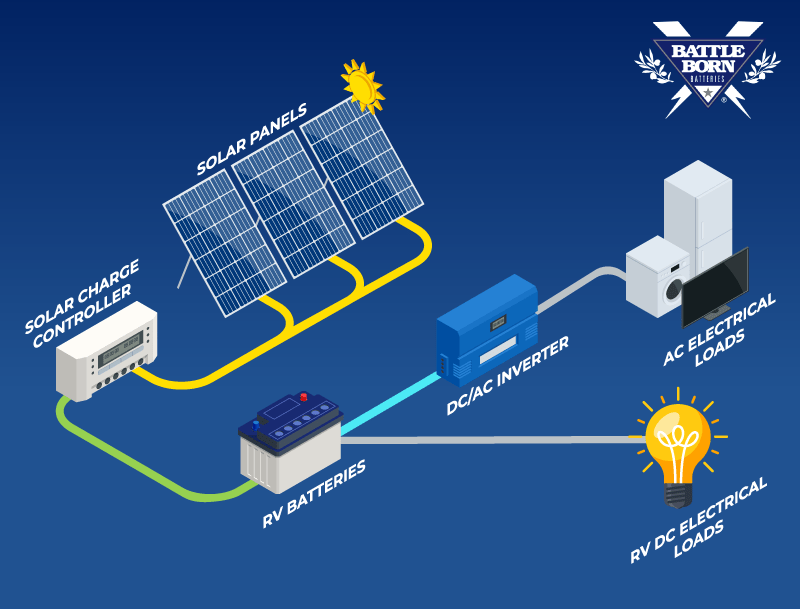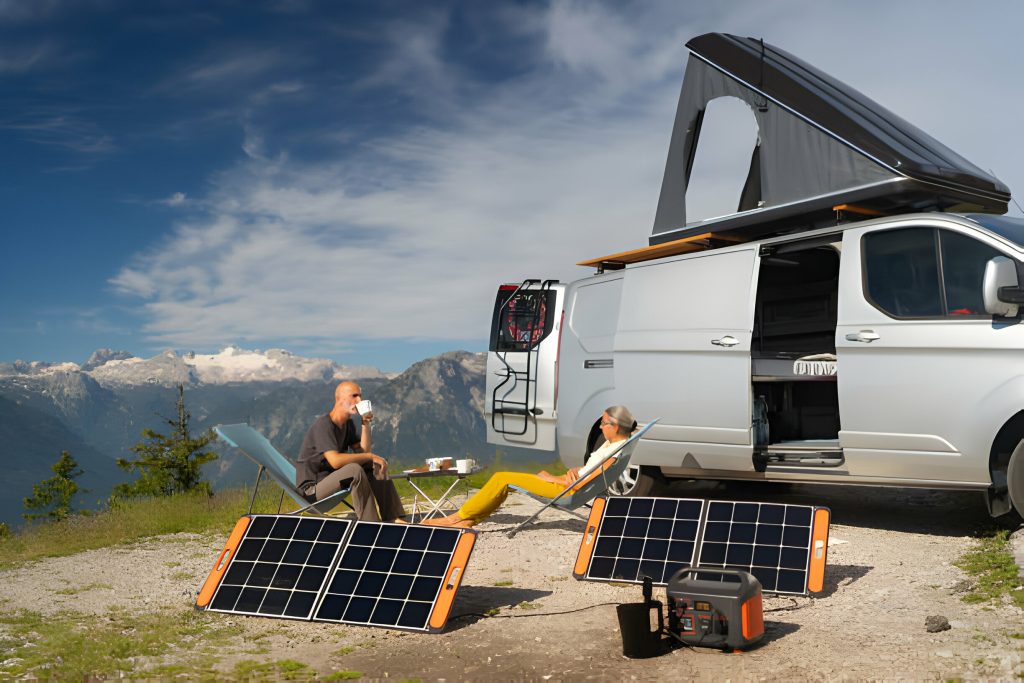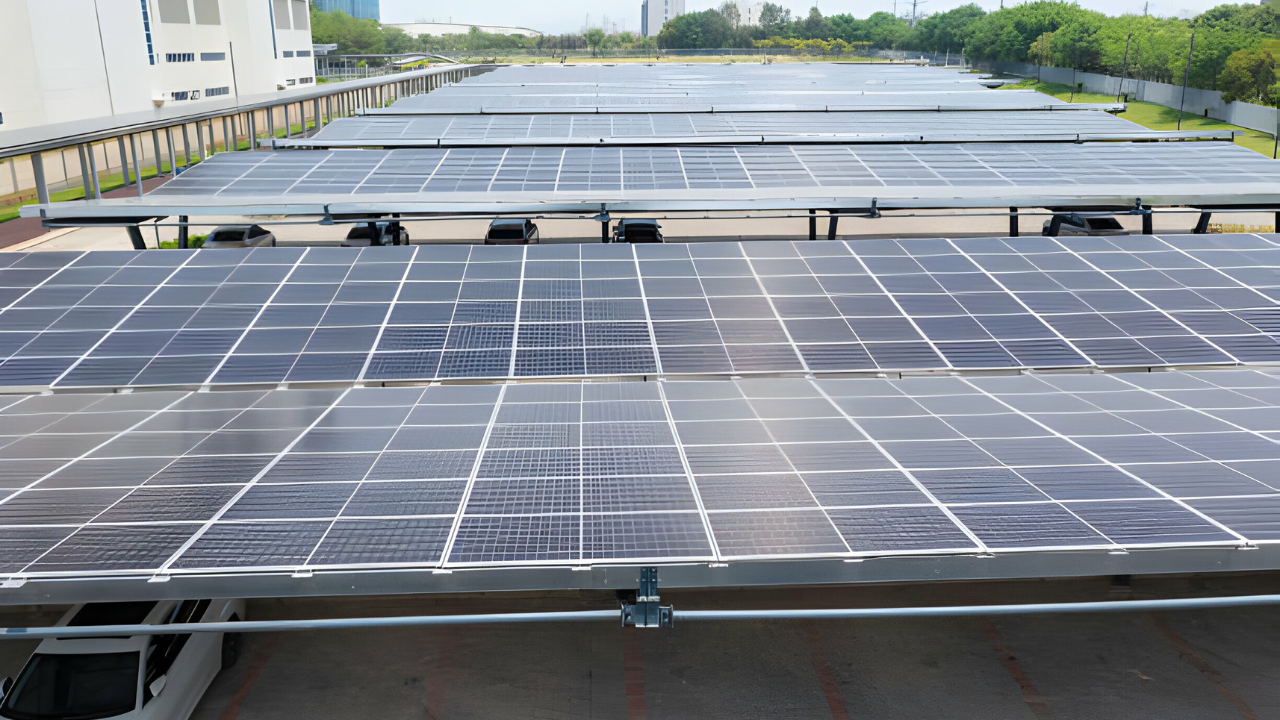To hook up solar panels to RV batteries, connect the solar panels to a charge controller, then connect the charge controller to the RV batteries. When it comes to powering your RV with solar energy, hooking up solar panels to the batteries can provide you with a sustainable and cost-effective power source for your travels.
By harnessing the sun’s energy, you can reduce reliance on traditional fuel sources and minimize your carbon footprint. We will explore the simple and efficient process of connecting solar panels to your RV batteries, allowing you to enjoy the freedom of off-grid living while on the road.
We will provide a step-by-step guide to help you understand the necessary equipment and the correct wiring setup, ensuring a smooth and successful installation. So, let’s dive into the world of solar power for your RV and embrace a more environmentally conscious way of traveling.
Choosing The Right Solar Panels For Your RV
When choosing the right solar panels for your RV, selecting the panels that best suit your energy needs and the size of your RV is crucial. With various options available in the market, understanding the power requirements of your RV and calculating the appropriate solar panel size are essential steps in the decision-making process.
Determining Your Power Needs
Determining the power needs of your RV involves understanding the electrical appliances and devices that the solar panels will power. Please list all the electronics, lights, and other power-consuming items in your RV and calculate their total power consumption in watts.
Next, consider the average daily usage of these appliances to estimate the amount of power required per day. This will help you determine the capacity of solar panels needed to meet your energy demands.
Calculating The Solar Panel Size
Once you clearly understand your power needs, it’s essential to calculate the appropriate solar panel size for your RV. To calculate the solar panel size, consider the average sunlight hours in your location and the efficiency of the solar panels you are considering.
Utilize the formula: Solar panel size (in watts) = Daily power consumption (in watt-hours) / Average sunlight hours × Efficiency factor to determine the ideal solar panel size that will effectively charge your RV batteries.

Credit: battlebornbatteries.com
Installing The Solar Panels On Your RV
Installing solar panels on your RV is a great way to harness the sun’s power and take your off-grid adventures to the next level. By setting up a solar power system, you can enjoy the freedom of camping without worrying about running out of battery power.
In this article, we will guide you through installing solar panels on your RV, ensuring you can enjoy clean, renewable energy wherever your travels take you.
Finding The Best Mounting Location
Before you begin the installation process, it’s crucial to determine the best location to mount your solar panels. Look for a flat, unobstructed area on your RV’s roof that receives ample sunlight throughout the day.
Remember any existing roof features or obstructions that may impact the panels’ efficiency. You can use a solar pathfinder tool to analyze the sun’s path and identify the optimal mounting location for maximum solar exposure.
Securing The Solar Panels
Once you’ve identified the ideal mounting location, it’s time to secure the solar panels. Utilize sturdy mounting brackets or rails that are designed explicitly for RV installations.
Ensure the mounting hardware is compatible with your RV’s roof material to prevent damage. Secure the panels tightly to minimize any potential movement or shifting during travel, using stainless steel bolts and screws for added durability.
Wiring The Panels To The Batteries
After securing the solar panels, the next step is to wire them to your RV’s batteries. Use high-quality solar cables to connect the panels to a solar charge controller, which regulates the flow of electricity to the batteries.
Ensure the wiring is neat and free of potential hazards, such as sharp edges or intense heat sources. Follow the manufacturer’s instructions carefully to properly connect the panels to the charge controller and the batteries, ensuring a safe and efficient power flow.
Setting Up An Efficient Solar Power System
Setting up an efficient solar power system is crucial when living off the grid in your RV. Not only does it allow you to harness the sun’s power, but it also ensures that you have a reliable energy source wherever you go. This article will explore three critical steps when hooking sole panels to RV batteries.
By using a solar charge controller, optimizing battery capacity, and adding an inverter for AC power, you can maximize the efficiency and effectiveness of your solar power system.
Using A Solar Charge Controller
One of the first steps in setting up your solar power system is to use a solar charge controller. This device serves as a regulator between the solar panels and your RV batteries. A solar charge controller can prevent overcharging and ensure your batteries are charged optimally.
The controller monitors the voltage and current from the solar panels and adjusts the charging process accordingly. It also protects your batteries from damage caused by excessive charging or discharging.
Optimizing Battery Capacity
Optimizing battery capacity is another essential aspect of setting up an efficient solar power system. This involves choosing the right type of batteries for your RV and ensuring they are adequately maintained. Deep cycle batteries are typically recommended for solar power systems as they are designed to provide steady power over an extended period.
Regularly checking the battery fluid levels, cleaning the terminals, and avoiding over-discharging is crucial for maximizing battery capacity. Additionally, using a battery monitor can help you keep track of the state of charge and know when it’s time to recharge.
Adding An Inverter For AC Power
Adding an inverter for AC power is necessary to enjoy the comforts of home while on the road. An inverter converts the DC power generated by your solar panels and stored in your batteries into AC power that can operate appliances and electronic devices in your RV.
When choosing an inverter, consider its power rating, efficiency, and waveform quality. A pure sine wave inverter is ideal as it produces a clean and stable power output, ensuring that your sensitive electronics and appliances run smoothly and efficiently.
In conclusion, setting up an efficient solar power system for your RV involves using a solar charge controller, optimizing battery capacity, and adding an inverter for AC power. By following these steps, you can ensure that your solar panels effectively charge your RV batteries and provide a reliable power source for all your needs while living off the grid.

Credit: 8billiontrees.com
Maintaining And Monitoring Your Solar Power System
Learn how to efficiently connect solar panels to your RV batteries and ensure optimal performance by regularly maintaining and monitoring your solar power system. Increase the lifespan of your system and enjoy an uninterrupted power supply on your outdoor adventures.
Maintaining and monitoring your solar power system is crucial to ensure its efficiency and longevity. By taking proper care of your solar panels and monitoring their performance, you can maximize their power generation and extend the life of your RV batteries.
This section will discuss three essential aspects of maintaining and monitoring your solar power system: cleaning the solar panels regularly, inspecting the wiring and connections, and monitoring power usage and generation.
Cleaning The Solar Panels Regularly
Properly cleaning your solar panels regularly is essential to ensure optimal power output. Dust, dirt, bird droppings, and other debris can accumulate on the surface, reducing the sunlight that reaches the solar cells. To clean your solar panels:
- Check the manufacturer’s guidelines for specific cleaning instructions.
- Use a soft cloth or sponge and a non-abrasive cleaning solution to wipe the solar panels’ surface gently.
- Rinse the panels with clean water to remove any remaining debris.
- Avoid using harsh chemicals or abrasive materials that could damage the panels.
Regular cleaning will help maintain the efficiency of your solar panels and ensure they are working at their full potential.
Inspecting The Wiring And Connections
Regularly inspecting the wiring and connections in your solar power system is essential to prevent any issues affecting its functionality. Follow these steps to inspect the wiring and connections:
- Check for any loose or damaged wires in the system.
- Tighten any loose connections using the appropriate tools.
- Look for signs of corrosion on the terminals and connectors.
- If corrosion occurs, clean the affected areas with a wire brush and a mixture of baking soda and water.
- Ensure all connections are secure and free of any obstructions or debris.
By regularly inspecting and maintaining the wiring and connections, you can prevent potential power loss and ensure the seamless operation of your solar power system.
Monitoring Power Usage And Generation
Monitoring your solar power system’s power usage and generation allows you to assess its performance and make necessary adjustments. Follow these steps to monitor your system effectively:
- Install a battery monitor to track the charge level of your RV batteries.
- Use a solar charge controller with an integrated monitoring system to measure the power the panels generate.
- Periodically check the battery voltage and charging current to ensure they are within the optimal range.
- Record your power usage and generation to identify any patterns or discrepancies.
- Make adjustments to your power consumption habits or system configurations if necessary.
Regular monitoring of your power usage and generation will help you optimize your solar power system’s performance and maximize efficiency.
Taking the time to maintain and monitor your solar power system is essential for its long-term success. By cleaning the solar panels regularly, inspecting the wiring and connections, and monitoring power usage and generation, you can ensure efficient power generation and prolong the life of your RV batteries. Follow these practices to make the most of your solar power system and enjoy the benefits of sustainable energy while on the road.
Maximizing Power Generation For Extended RV Trips
Are you planning an extended RV trip? One of the critical aspects to consider is how to maximize power generation. By efficiently harnessing the sun’s energy and implementing clever charging methods, you can ensure you have enough power to enjoy your adventure without worrying about draining your RV batteries.
In this blog post, we will explore three strategies to help you make the most out of your solar panels when powering your RV for those longer trips.
Using Portable Solar Panels For Extra Power
Regarding generating extra power for your RV, portable solar panels are your best bet. These lightweight and easy-to-install panels are designed to provide an additional boost to your power generation capacity. By simply placing the portable panels in direct sunlight and connecting them to your RV batteries, you can increase your energy production and extend the lifespan of your batteries.
Portable solar panels offer flexibility as they can be easily repositioned throughout the day to ensure optimal solar exposure. They are also compact, making them perfect for RV owners who are constantly moving. Investing in high-efficiency portable solar panels will enable you to generate more power and maximize your energy production during those extended trips.
Utilizing Multiple Charging Methods
To maximize power generation during your RV adventures, it’s crucial to utilize multiple charging methods. Alongside solar panels, you can leverage other charging sources, such as a generator or shore power, to recharge your batteries. By combining these methods, you can ensure a steady flow of energy to power your RV even when the sun is not shining as brightly.
An intelligent charger is essential when connecting your RV to shore power. Smart chargers help regulate the charging process, optimizing battery performance and prolonging lifespan. Furthermore, investing in a charger with a higher amperage rating can significantly reduce charging time, allowing you to get back on the road faster.
Implementing Energy-efficient Practices
While solar panels and multiple charging methods are effective strategies to maximize power generation, implementing energy-efficient practices is equally important. By adopting habits that consume less power, you can stretch the lifespan of your RV batteries even further. Here are a few energy-saving tips to keep in mind:
- Switch to LED lights: LED lights consume less energy and last longer than traditional incandescent bulbs.
- Use energy-efficient appliances: Opt for energy-efficient versions of appliances like refrigerators, air conditioners, and heaters.
- Insulate your RV: Proper insulation will help maintain a comfortable temperature inside your RV, reducing the need for excessive heating or cooling.
- Avoid unnecessary openings: Minimize the opening of doors and windows repeatedly to prevent energy loss.
- Regularly monitor power usage: Keep tabs on your power consumption using a monitoring system or device to identify any energy vampires that may be draining your batteries unnecessarily.
By implementing these energy-efficient practices, you can reduce your power consumption and extend the life of your RV batteries, allowing for longer and more enjoyable trips.

Credit: 8billiontrees.com
Complete RV solar system with batteries
To set up a complete RV solar system with batteries, you will need the following components:
- Solar Panels: Determine the appropriate number and capacity of solar panels based on your energy needs and available space on the RV roof.
- Charge Controller: Install a solar charge controller to regulate the charging process, prevent overcharging, and protect your batteries.
- Batteries: Choose deep-cycle batteries suitable for RV use. The number and capacity depend on your energy requirements.
- Inverter: If you need AC power for appliances, include an inverter to convert DC power from the batteries into usable AC power.
- Wiring and Connectors: Use appropriate wiring and connectors to connect the solar panels, charge controller, batteries, and inverter.
- Battery Monitor: Install a monitor to track battery status and ensure efficient power management.
- Mounting Hardware: Securely mount the solar panels on the RV roof using suitable brackets and hardware.
- Fuses and Breakers: Include fuses and breakers to protect components from electrical issues.
- Solar Panel Mounts: Use mounts to secure the solar panels to the RV roof and allow for proper angling.
- Cables and Junction Boxes: Use proper cables and junction boxes for a neat and safe installation.
Ensure the system is adequately sized, wired, and installed to maximize solar energy capture and storage. If unsure, consult a solar power professional for a customized setup based on your specific RV and energy needs.
RV Solar Panel Kit with battery and inverter
You’ll find various options on the market when looking for an RV solar panel kit that includes a battery and inverter. These kits are designed to provide a convenient and comprehensive solution for RV solar power. Here’s what you can typically expect in such a kit:
- Solar Panels: The kit will include solar panels with a specified wattage. The number and capacity of panels depend on the kit and your energy needs.
- Charge Controller: A solar charge controller regulates the charging process and protects the battery from overcharging.
- Battery: The kit will come with deep-cycle batteries suitable for RV use. The capacity may vary, and some kits may include multiple batteries.
- Inverter: An inverter is typically part of the kit to convert DC power from the batteries into usable AC power for your RV appliances.
- Wiring and Connectors: The necessary wiring and connectors for connecting the solar panels, charge controller, battery, and inverter are usually included.
- Mounting Hardware: Kits often include mounting hardware for securing the solar panels to the RV roof.
- Battery Monitor: Some kits may include a battery monitor to help you keep track of your battery’s status.
- Cables and Junction Boxes: Kits generally provide the required cables and junction boxes for a complete and safe installation.
When choosing a kit, consider your RV’s energy needs, the available roof space for solar panels, and the capacity of the included battery. It’s advisable to review product specifications and possibly consult with the kit manufacturer or a solar power professional to ensure that the kit meets your specific requirements.
Off-grid RV solar system
An off-grid RV solar system is designed to provide power to your RV without relying on external electrical sources. Here are the key components typically included in an off-grid RV solar system:
- Solar Panels: These capture sunlight and convert it into electricity. The number and capacity of panels depend on your energy needs and available roof space on the RV.
- Charge Controller: A solar charge controller regulates the charging process, preventing overcharging and ensuring optimal battery health.
- Batteries: Deep-cycle batteries store the solar-generated power for use during periods of low sunlight or at night.
- Inverter: An inverter converts DC power stored in the batteries into AC power, allowing you to run appliances that require alternating current.
- Wiring and Connectors: High-quality wiring and connectors are essential to connect the solar panels, charge controller, batteries, and inverter efficiently and safely.
- Battery Monitor: A battery monitor helps you keep track of the state of charge and overall health of your batteries.
- Mounting Hardware: This includes brackets and hardware to mount the solar panels on the RV roof securely.
- Cables and Junction Boxes: Necessary components for a neat and organized wiring setup.
When setting up an off-grid RV solar system, consider your power consumption needs, the available roof space for solar panels, and the type of appliances you plan to run. Proper sizing and installation are crucial for optimal performance. If you’re not confident in designing and installing the system, consider consulting with a solar power professional or purchasing a pre-configured off-grid RV solar kit.

Frequently Asked Questions Of How To Hook Up Solar Panels To Rv Batteries
How Do I Hook Up Solar Panels To My Rv Batteries?
To hook up solar panels to your RV batteries, first, you’ll need a solar charge controller to regulate the power flow. Then, connect the positive and negative wires from the solar panels to the charge controller. Finally, connect the charge controller to your RV batteries, ensuring proper polarity and cable gauge for a safe and efficient connection.
What Size Solar Panel Do I Need For My RV Batteries?
The solar panel size you need will depend on factors such as your RV’s power consumption, battery capacity, and the amount of sunlight available. Generally, a 100-watt solar panel is a good starting point. However, it’s recommended to calculate your specific needs with a solar calculator or consult an expert to determine the correct panel size for your RV batteries.
Can I Run My RV solely On Solar Power?
You can run your RV solely on solar power by installing sufficient solar panels and a suitable battery bank. However, it’s essential to consider your power requirements and usage habits to ensure the solar system meets your needs.
Maximizing energy efficiency through LED lighting and using energy-efficient appliances can also help extend your solar power run time.
How do you attach a solar panel to an RV battery?
To attach a solar panel to an RV battery, connect the positive (+) terminal of the solar panel to the positive terminal of the battery and the negative (-) terminal of the solar panel to the negative terminal of the battery using appropriate wires and connectors. Use a solar charge controller between the panel and the battery to regulate the charging process and prevent overcharging.
How many solar panels does it take to charge an RV battery?
The number of solar panels needed to charge an RV battery depends on factors like battery capacity, daily energy consumption, and solar panel efficiency. As a rough estimate, one or two 100-watt solar panels may be sufficient for essential charging, but a more accurate calculation is recommended based on your specific needs and conditions.
Can I plug a solar panel directly into my RV?
It’s generally not recommended to plug a solar panel directly into your RV’s battery without a solar charge controller. A solar charge controller regulates the voltage and current from the solar panel to prevent overcharging and protect your RV’s battery. A charge controller is a standard practice for a safe and effective solar setup.
How do you hook up batteries to solar panels?
To hook up batteries to solar panels:
- Connect the solar panel’s positive (+) terminal to the battery’s positive terminal.
- Connect the negative (-) terminal of the solar panel to the negative terminal of the battery.
- Use appropriate wires and connectors.
- Install a solar charge controller between the solar panel and the battery for regulation and protection.
Will solar panel keep my RV battery charged?
Yes, solar panels can help keep your RV battery charged by converting sunlight into electricity, provided the solar panel capacity matches your battery’s needs. Using a solar charge controller is essential to regulate charging and prevent overcharging.
What do I need to solar charge my RV battery?
It would be best to have solar panels, a solar charge controller, appropriate wiring, and connectors to charge your RV battery. Ensure the solar panel capacity matches your battery needs, and consider additional components like an inverter for AC power if required.
Conclusion
Incorporating solar panels into your RV battery system is a cost-effective and eco-friendly way to power your adventures. Following the step-by-step guide outlined in this blog post, you can confidently embark on your off-grid journeys, knowing you have harnessed the sun’s power to fuel your adventures.
So, go ahead, take the plunge, and enjoy the freedom that solar energy brings to your RV lifestyle.

I am a Mahdi . I have four two of experience in Technology and all types of Battery’s like Solar Battery, Car Battery, Lithium Battery etc. So I work on solving these issues and give various tips on these issues.
